Stir Fry Technique III: Ten Steps to Better Tofu From a Wok
Following my post Stir Fry Technique: Ten Steps to Better Wok Cookery, I wrote a post specifically dealing with chicken, Stir Fry Technique II: Ten Steps to Better Chicken From a Wok. When I wrote that post, there were many requests for a similar post about tofu, so finally, after much trial and error, testing and tasting, here it is. (With a big thank you to Dan for the many fine photographs he took for this post last night when he showed up around dinnertime last night. He’s always good-natured about being drafted into my blogging schemes, and besides, he then gets to eat dinner, which makes it all good all the way around.)
Before we dive into step one, I want to refer future readers to the introduction to this post, written yesterday: Stir Frying Tofu Part I: Choose Your Tofu Wisely. Carefully following the suggestions in this post will go a long way towards ensuring success in stir frying tofu. The key is to get tofu that is as firm as possible, and to avoid any silken tofu for stir frying, even if it says on the package that it is “extra firm” and suitable for stir frying. While one -can- use it for stir frying, it is difficult to do, and the likely result is a mushed up mess in the middle of a wok.
That said, note that the example I provide here was made with Spring Creek brand tofu which is the firmest Chinese-style tofu I have ever used. It does not require any preparation other than slicing and marinating before stir frying. However, other brands do require a ylittle more work to make them foolproof in the wok. More simple yet is the spiced dry tofu which does not even require marination, and in fact, is pretty much a “slice and go” sort of product. If you are using spiced dry tofu, you will not need to follow every step of this guide, and in fact, are working with a product that is even easier to stir fry than meat. My advice is that if you can find spiced dry tofu, get it and try it out. If you like the flavor and texture, use it as your default tofu for stir-frying, especially if you want to create dinner in a hurry.
Step One: Determine if your tofu will work as is or if it needs to be pressed. If it requires pressing, press it.
The easiest way to do this is to slice a piece about 1/2″ thick off the narrow side of the tofu and pick it up between thumb and forefinger and give it a gentle, but firm shake. If it holds together fine, you are good to go. If it cracks, tears, falls apart of squishes, you need to press a bit more water out of it before it is ready to stand up to the rigors of stir frying.
If your tofu needs to be pressed, start this about five hours or so before dinner. (Or, do it the night before.) Unwrap your tofu and drain out all the water from the package. Set the block(s) of tofu on a rack or screen of some sort–I use a splatter shield, as illustrated to the right–over a bowl. Put a plate flat on top of the tofu, then set heavy objects like one of those food service cans of green beans that you see in school cafeteria kitchens, or a couple of doorstop-sized cookbooks or a clean (!) cinderblock on top of the plate. Allow the tofu to be squeezed for at least five hours, though you can, if you have room for it, stuff the whole kit and kaboodle into a fridge for overnight pressing.
Once that is done, disassemble your impromptu tofu press and proceed onto the next step.
Step Two: Slice and marinate your tofu.
As with all other stir fry ingredients, you want your tofu to be cut into uniform sizes and shapes, for several reasons. The primary reason is that you want them to cook evenly in the wok. There is nothing worse than a stir fry where half of the ingredients are overcooked and the other half undercooked, because they were not cut evenly. The second, and equally important reason from a Chinese perspective, is aesthetic–foods that are evenly cut are more pleasing to the eye and appetite.
My guidelines for cutting tofu that is going to be cooked in a wok delve more into thickness than width or height. The reason for this is because if you cut the tofu too thinly, it is more likely to break apart as you start stirring it in the wok. If you cut it too thickly, however, it is not going to cook as well on the inside as it does on the outside.
This rule applies only to fresh tofu; spiced dry tofu can be cut quite thin, because it is so compressed before you even bring it home from the store. I cut spiced dry tofu quite thin–around 1/8″ inch, typically, and unless I cook it for a long time, it does not become overcooked.
I like to cut fresh tofu to a thickness of about 1/2 inch. I do this as illustrated by setting the tofu block upright on the board, with the square top upwards. I then cut 1/2 inch thick slices across the block. Then, I cut each slice in half, into a flat square–as seen in the first photograph for this post. For more bite-sized pieces, one can also take each of those squares, and cut them on the diagonal into triangles–this shape is very pretty, especially when cooked with greens which are amorphous in shape, and fresh or rehydrated shiitake mushroom caps which have been cut into halves.
After the fresh tofu is cut, it needs to be marinated. For this tofu recipe, I used a mixture of dark soy sauce and Shao Hsing wine. One could also use light soy sauce, tamari soy sauce or fish sauce in the marinade, but I chose dark soy sauce because not only is it salty, it has a hint of sweetness in it because it has caramel or molasses in it, and it gives a fantastic deep, rich color to the tofu.
Unlike most meats, one cannot add cornstarch to the marinade and expect it to stick evenly to the tofu. I find that if I don’t put the tofu into a dish large enough to contain it all in one layer, I end up having to rotate the tofu slices from the bottom to the top. It is best just to use a shallow dish, and enough marinade to cover the bottom of the dish. After the tofu has marinated for fifteen minutes on one side, it is a simple matter to turn it over, and allow the top to come into contact with the marinade. This allows the marinade to evenly penetrate all sides of the tofu, and will result in a better color for it when it is cooked.
Step Three: When you are ready to stir fry, remove the tofu from the marinade, and either dredge it in cornstarch or pat it dry with paper towels.
The purpose of either of these actions is twofold. One, it keeps the wok from sputtering and spewing splatters of hot oil all over you when the liquid marinade hits the hot wok. Two, it helps develop a rich brown outer surface on the cooked tofu.
Which do I mean for you to do? Well, that depends on the final outer texture you want your tofu to have. In both cases, you will end up with a browned outside layer, but if you use a dredge of cornstarch to dry the tofu, you will end up with an interesting, soft, slippery outer layer. If you simply pat the tofu dry with paper towels, it will develop a chewy, lightly crispy outer layer. So, it is all up to you. Do one or the other, or else suffer a splatter of hot oil up and down your forearms which can hurt enough to make you want to swear off stir frying tofu forever.
One thing, though–if you don’t use the cornstarch on the tofu, add a little bit of it to the marinade left in the dish. This you can use to thicken the sauce later in the cooking process. If you coat the tofu with cornstarch, you can skip that step–there will be enough cornstarch in the wok from the tofu alone to thicken the sauce otherwise.
Step Four: Heat your wok until it smokes, then add oil. Then, add all of your aromatic ingredients except garlic. Cook the aromatics until they are about half done.
This part is the same as cooking anything in the wok, except for a few points. You can use a tiny bit less oil in cooking tofu than you would use in cooking meat, but not much less. I usually cut my oil down by a tablespoon for tofu, so I go from 3-4 tablespoons to 2-3.
I leave out the garlic until after the tofu is in the wok for several reasons, most of which has to do with how long it takes the surface of the tofu to brown. (It takes longer than thinly sliced meats.) By the time the tofu starts browning, any garlic that is in the wok, against the metal surface, will brown. That is why I let the tofu itself shield the garlic, while the tougher aromatics like onions, scallions, ginger, chile and fermented black beans cook all around, under and on top of the tofu.
Step Five: Gently place the tofu into a single layer on the bottom and lower sides of the wok. Then spread the uncooked garlic over the tofu. Then leave the tofu to sit in the wok, untouched, until it browns on the bottom.
What I try to do is scoot the aromatics up near the edges of the wok, out of the way. If a few onions or bits of ginger get left behind, don’t worry overmuch about it. Then, I carefully set each piece of tofu in place BY HAND. This means, you have to be careful, because you are setting food onto a very hot surface. Just be careful. But don’t dump the tofu into the wok the way you do meat. If you do that and then try to move the tofu into a single layer on the wok in order to get it to brown, you will likely break it up, and there goes your pretty, perfectly cut pieces.
Once you have the tofu set out into a single layer, scrape or scoop your aromatics down around and over the tofu. This adds flavor to the tofu, as well as keeps your aromatics cooking. Putting all of the tofu into the wok at one time lowers the temperature a bit, but if you have your flame on high, it will rise quickly enough. But it is lowered enough to keep from burning the aromatics while the tofu is busy browning.
Sprinkle the garlic over the tofu, and let it sit in the hot wok gently warming, shielded from the very hot metal by the tofu.
How long does it take the tofu to brown? About a minute or two, usually. You can smell it and see it–the edges will start to look brown. Or, you can scrape up a piece with your wok spatula and peek under it. If it is still pale, or worse, if it sticks, it is still working on browning. Lay it back down and let it go back to work, while you work hard at leaving it alone.
Step Six: Gently flip over the tofu, and spread it into a single layer, then leave it alone to brown the other side.
This is probably the most difficult part of the entire procedure, and this is where you are most likely to break up your tofu. You must “have the courage of your convictions” as Julia Child would say, and sliding your shovel under two or three pieces of tofu at a time, give a quick flip of the wrist and turn them in one move, then gently slide them in place so they have as full contact with the hot metal of the wok as possible. Then, you have to repeat the action as many times as necessary to do every piece of tofu.
The browning of the tofu toughens it considerably, and makes it more able to withstand rigorous stirring. But in its half-cooked state, it is particularly vulnerable to breaking. So, turn it this time in as few movements as possible, then settle it back down on the bottom of the wok and allow it to brown on the second side, which will again take a minute or two of undisturbed cooking.
As you can see, this method of cooking tofu results in a deeply browned, flavorful exterior, which is both aesthetically pleasing to look at as well as having a good texture. The dark soy sauce will make a darker crust, but while a lighter soy sauce creates a paler result it is still pretty, and very tasty as well.
Step Seven: Once the tofu is cooked on the second side, flip it over, then add any additional vegetable ingredients in the order in which they are meant to cook, from those that take longest to cook, to those which quick quickly.
So, flip all of the tofu back over, and start adding other ingredients. At this point in time, now that both sides of the tofu are browned, you may more vigorously stir fry than you did in the beginning, because browning toughens up the tofu. It is now able to withstand less gentle treatment, so it is at this point you pick up the pace and cook like you are on Iron Chef.
When you first start trying these techniques for cooking tofu, I suggest that you limit the number of vegetables you add to the mixture to one or two., for the sake of simplicity.
In the recipe I used to illustrate this post, I only added kale. (The recipe is a simplified version of my tofu and chard recipe here: I left out the chicken, the honey, the light soy sauce, the chile and replaced the sesame oil with oyster sauce. ) If you wanted to add a second vegetable to this dish, I would consider something crispy, like carrots, in which case, you would add the carrots first, and then add the kale after that.
When you are more adept at stir frying tofu, feel free to add as many different vegetables as you like.
Step Eight: Deglaze the wok, and add marinade mixture to the wok in order to begin making the sauce.
Add whatever liquid you want to the wok to deglaze any browned bits stuck to its surface. In this case, I used wine, but one could use chicken stock or vegetable broth just as easily. If you are cooking greens with this dish, as I did, deglaze the pan first, pouring in the liquid, and scraping and turning the food, stirring in the browned bits that you scrape off the sides of the wok. Then, add the greens on top of the wok which is now steaming from the liquid which is boiling away. Add a little more of your deglazing liquid, and stir the greens, until they begin to wilt.
Step Nine: Add the marinade ingredients to thicken the sauce and give it color.
This step is simple–if you didn’t use cornstarch with the tofu, you add it now, dissolved into the marinade ingredients, and stir the contents of the wok to allow the sauce to thicken. If you dredged the tofu in cornstarch, you just add the unadorned marinade ingredients and stir, while the sauce thickens and boils.
Step Ten: Add whatever finishing touches you want to the dish, stir and remove from the heat, and serve.
This refers to any final additions to the sauce, such as sesame oil or oyster sauce, which are stirred in at the last minute, or to any garnish such as sliced scallion tops, chopped cilantro or crushed peanuts. Just stir them in, turn off the heat and scrape the finished dish out of the wok and into a serving platter or bowl.
That is all there is to cooking fresh tofu in a wok. It is really simple, once you get the knack of it. And once you have a grip on the technique, you will find yourself wanting to make numerous tofu and vegetable dishes to suit every mood and palate. You will think of new marinades and sauces to try to make an endless number of variations on the simple dish of stir fried tofu.
There are other, additional techniques one can use to change the texture of your tofu before stir frying it. You can freeze it first, which gives it a chewier, spongier texture that soaks up marinades and sauces very well. Or, you can deep fry it, which makes it crisp on the outside and chewy on the inside. Or, you can pan fry it, then cut pockets into the tofu, stuff it with a filling and then stir fry it.
The possibilities are nearly endless.
I hope that this little guide has helped answer some questions, and opened doors for folks who have had troubles cooking tofu in the past. Personally, it is one of my favorite foods, and I hope that by posting about it, I have inspired others to jump into cooking it and experimenting with it.
10 Comments
RSS feed for comments on this post.
Sorry, the comment form is closed at this time.
Powered by WordPress. Graphics by Zak Kramer.
Design update by Daniel Trout.
Entries and comments feeds.



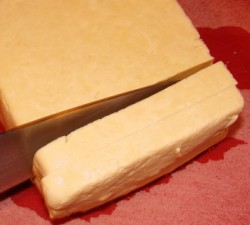
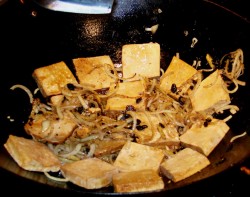
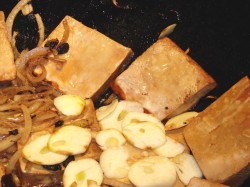
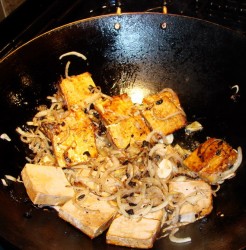
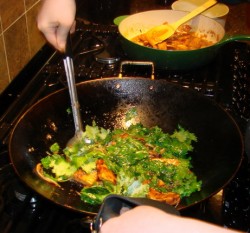


Hello, thanks for the very informative post!
Just as an alternative, have you ever tried (yes, probably you have) cutting the tofu into even smaller cubes? (eg. one of the slices in the photograph into 9 or 16 cubes) When they’re smaller they break up less easily and even if they do it doesn’t affect the dish that much.
Of course, the tofu isn’t meant to be eaten cube by cube if done this way, but spooned (with the sauce and etc.) onto rice and eaten.
Hm, I never press my tofu with such heavy objects, just one or two plates usually. But I do press it overnight. Maybe that makes up for it?
Comment by smazh — April 21, 2007 #
smazh–With some recipes, I do cut the tofu small–such as Ma Po tofu. Of course, that is a braised dish, not stir fried, now that I think on it….
I do remember cutting it smaller to stir fry early on in my tofu cooking attempts–lo, many years ago. Like, oh, twelve or thirteen years ago. And I was still using very soft tofu, and it still broke up and tasted odd and mushy.
I remember glaring down into the wok with a fierce frown and intoning in a faux Scottish brogue, “I dinna think the tofu can hold, Captain! She’s breakin’ up, sair, and there’s nothin’ to be doon aboot it.”
I was so cranky, too, because I had eaten my former employer, Chef Huy Khuu’s wonderful Bean Curd and Black Mushrooms and Beancurd Homestyle a zillion times, and he cut it large and stir fried it and it NEVER crumbled like that.
So, I worked and worked and worked.
And finally figured out that if I want to cook Chinese foods, I shouldn’t buy Japanese tofu. And then I learned the other tricks of freezing, pressing and all of that.
As for pressing with heavy weights–that is because I am impatient and you are not! I sometimes want to cook tofu tonight, and don’t have time to wait overnight for the water to be pressed out of it. So, I just press it with more weight and get the same result faster.
Comment by Barbara — April 22, 2007 #
These are great tips and will help me in my future tofu endeavors.
Another system that works decently for pressing tofu are the two trays that come with most toaster ovens. One has shallow ridges and holes, the other is a baking sheet. Although it doesn’t provide as much drainage area as a screen, it is better than nothing.
Comment by Marc — April 22, 2007 #
Thank you! I have a vegetarian friend I cook for occasionally. Now I’ll have more variety of recipies to choose from.
Ardene
Comment by Ardene — April 23, 2007 #
I am again so lucky to live in SF where we have many many choices of tofu. I get the firm tofu at Rainbow Grocery and season it with curry and hot pepper. My last creation (cough cough) featured orzo pilaf with tofu, seasoned with curry spices and with fresh cilantro and mint chopped in at the last minute. I had a yogurt/mint dipping sauce, a green papaya salad and no left overs! The next time I’m going to hide a portion or two in the back of the cupboard for ME! to eat later on in the week.
Comment by Nancy — April 23, 2007 #
glad to see you’ve found Spring Creek tofu–it’s been our favorite for more than a decade, and its hard to convey to people who only have the Chinese style to work with. And, surprisingly, we’re just back from a month in Japan, where it was very difficult to find vegetarian food–everything (even tofu!) had fish sauce or broth involved—
Comment by Alan Woods — September 8, 2007 #
I can’t find any information or a website for the Spring Creek Tofu company. I would like to tell my local grocers to get this product, but who do they contact? (For Spring Creek Tofu).
Thanks for any info!
Pat in New Mexico
Comment by Pat — December 21, 2007 #
Pat, here is Spring Creek Tofu’s contact information:
Spring Creek Natural Foods
212-C E. Main St.
Spencer, WV 25276
304-927-3780
FAX: 304-927-1815
Products: Wheat and soy products, bread, organic, smoked, and baked tofu, fresh soymilk, vegan frozen soups and chili, etc.
I hope that this is current–if it turns out not to be, contact me again and I will do what I can to find out current contact info for you.
I guarantee this will be among the best tofu you have ever eaten in your life. I promise.
Comment by Barbara — December 24, 2007 #
[…] Topsy Retweet Button topsyWidgetPreload({ “url”: “http://www.tigersandstrawberries.com/2007/04/20/stir-fry-technique-iii-ten-steps-to-better-tofu-from-a-wok/”, “title”: “Tigers & Strawberries » Stir Fry Technique III: Ten Steps to Better Tofu From a Wok”, “order”: “count,badge,retweet” }) Add Topsy Retweet Button to your Blog or Web Site. WordPress Web Sites 1 tweet tweet […]
Pingback by Twitter Trackbacks for Tigers & Strawberries » Stir Fry Technique III: Ten Steps to Better Tofu From a Wok [tigersandstrawberries.com] on Topsy.com — May 10, 2010 #
[…] (Source) […]
Pingback by TofuXpress Review | From Fried Chicken To Tofu — February 17, 2011 #